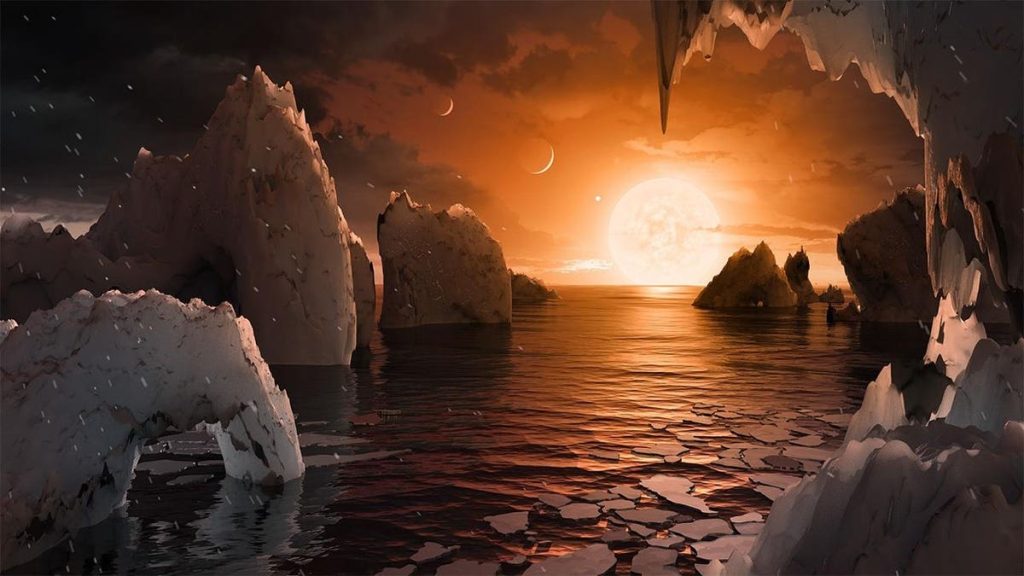TRAPPIST-1 fascinates planetary scientists. Just 39 light-years from us exist seven planets orbiting a star. It’s not an exact match for our solar system—the host star is a red dwarf, a star much cooler than the sun—but all of the seven planets are rocky, Earth-sized and, in at least some ways, Earth-like.
Dubbed “Solar System 2.0” by many exoplanet scientists, TRAPPIST-1 has the most Earth-sized planets found in the habitable zone of a single star, announced NASA in 2017 after its infrared-capable Spitzer Space Telescope had a look.
Whether any of these planets are actually Earth-like is unknown, but exoplanet-hunters have been waiting for JWST to take a look for any signs of an atmosphere around any of the planets. The easiest planet to study is TRAPPIST-1 b, because it’s the closest to its star—so the hottest and brightest. In May this year it was studied using JWST’s MIRI infrared cameras. Now comes a study using JWST’s NIRISS instrument, which splits white light from stars into its colour components—like a rainbow.
No Sign Of An Atmosphere
A paper published this week in The Astrophysical Journal Letters did not see signs of an atmosphere around TRAPPIST-1 b. “This tells us the planet could be a bare rock, have clouds high in the atmosphere or have a very heavy molecule like carbon dioxide that makes the atmosphere too small to detect,” said Ryan MacDonald, as astronomer at the University of Michigan astronomer and NASA Sagan Fellow, in a press release. “But what we do see is that the star is absolutely the biggest effect dominating our observations, and this will do the exact same thing to other planets in the system.”
This is not good news, but nor is it particularly bad. Finding signals of an atmosphere from 39 light-years away isn’t exactly easy, so early studies are focusing on learning how the host star affects observations of TRAPPIST-1 system planets. “If we don’t figure out how to deal with the star now, it’s going to make it much, much harder when we look at the planets in the habitable zone—TRAPPIST-1 d, e and f—to see any atmospheric signals,” said MacDonald. A star’s habitable zone is where liquid water could theoretically exist on a planet’s surface.
‘Ghost Signals’
Scientists only know about the existence of planets around TRAPPIST-1 because they transit across the star as seen from the solar system. That’s a happy accident, but it also helps in the search for exoplanets. This study used a technique called transmission spectroscopy, using NIRISS to split the star’s light as it passed through the atmosphere of TRAPPIST-1 b. In that light was the fingerprint of the molecules and atoms found within the planet’s atmosphere.
However, what the scientists did find was a bunch of “ghost signals” in the starlight that appeared to come from dark and bright spots on the star itself. This data could be crucial in preventing future studies from jumping to conclusions about detecting a particular molecule in the exoplanet’s atmosphere.
Flare Event
Perhaps the major difference between TRAPPIST-1 and our solar system is its central star. TRAPPIST-1 is a red dwarf star, which are way more common that sun-like stars. TRAPPIST-1b gets four times more radiation than the Earth does from the sun and has a surface temperature between 120 and 220 degrees Celsius, discovered the scientists. So it’s not in the habitable zone. Red dwarf stars are less predictable than the sun—and that could have consequences for life. “We saw a stellar flare, an unpredictable event during which the star looks brighter for several minutes to hours,” said Olivia Lim of the Trottier Institute for Research on Exoplanets at the University of Montreal, who led the research. “This flare affected our measurement of the amount of light blocked by the planet … we need to account for them to ensure that we interpret the data correctly.”
A Thin Atmosphere?
Although no atmosphere was detected on TRAPPIST-1b, the study was unable to rule out a thin atmosphere—perhaps of pure water, carbon dioxide or methane. It’s also possible that TRAPPIST-1 b has an atmosphere similar to that of Saturn’s giant moon Titan, the only moon in the solar system with a thick atmosphere (about 1.5 times the atmospheric pressure of Earth).
TRAPPIST-1 Revealed
Although the star was first discovered in 1999, the TRAPPIST-1 system is thus named because in 2016 three planets were discovered by scientists using the Transiting Planets and Planetesimals Small Telescope at Chile’s La Silla Observatory. The following year Spitzer spent over 1,000 hours observing TRAPPIST-1, finding seven planets as well as their mass, radius and densities—and all were rocky, Earth-sized worlds.
Wishing you clear skies and wide eyes.
Read the full article here








